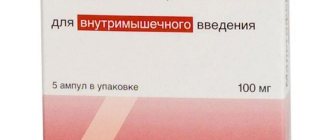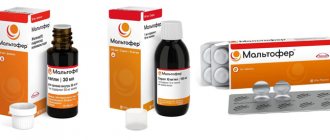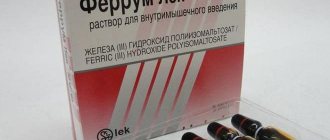Contraindications
The use of Venofer, according to the instructions, is contraindicated:
- For anemia, if it is not associated with iron deficiency;
- In the first trimester of pregnancy;
- In case of hypersensitivity to the drug;
- Patients who have signs of iron overload (hemochromatosis or hemosiderosis);
- In case of violations of the Fe utilization process.
The drug is prescribed, but with extreme caution, for the following diseases and conditions:
- Eczema;
- Bronchial asthma;
- Kidney failure;
- Acute and chronic infectious diseases;
- Polyvalent allergy;
- A history of indications of allergic reactions that occurred during parenteral use of iron preparations;
- Low iron-binding capacity of serum and/or folic acid deficiency;
- Increased levels of ferritin in blood serum.
Pharmacological properties
Pharmacodynamics
The active component of Venofer is an iron-sucrose complex, which is a core of polynuclear iron (III) hydroxide, which is surrounded by a large number of non-covalently bound sucrose molecules. The average molecular weight of this complex is about 43 kDa. The structure of the multinuclear iron-containing core is similar to the structure of the core of the ferritin protein, which functions as a physiological iron depot.
The complex allows you to create a controlled source of utilized iron for ferritin and transferrin, which are responsible for the deposition and transport of iron in the body.
After intravenous administration of the complex, its multinuclear iron-containing core is predominantly captured by the reticuloendothelial system of the liver, bone marrow and spleen. At the next stage, iron is consumed for the synthesis of hemoglobin, myoglobin, and other iron-containing enzymes or stored in the form of ferritin in the liver.
Pharmacokinetics
In a study involving patients with chronic renal failure and anemia, the ferrokinetics of a 59Fe and 52Fe labeled iron-sucrose complex was studied. It was shown that within 6–8 hours the 52Fe complex was taken up by the spleen, bone marrow and liver. The process of radiolabel uptake by macrophage-rich spleens is thought to be typical of iron uptake by the reticuloendothelial system.
Healthy volunteers received a single intravenous dose of Venofer containing 100 mg of iron. In this case, with an average concentration of 538 µmol/l, the time to reach maximum total concentrations of iron in the blood serum was 10 minutes after administration. The volume of distribution of the central chamber corresponded to the plasma volume (approximately 3 L).
Most of the sucrose is broken down after injection. The multinucleated iron-containing core is predominantly taken up by the reticuloendothelial system of the spleen, bone marrow and liver. After 4 weeks, 59–97% of iron is utilized by red blood cells.
The average molecular weight of the iron-sucrose complex is approximately 43 kDa, which is sufficient to prevent its excretion by the kidneys.
Excretion of iron through the kidneys during the first 4 hours after intravenous injection of an equivalent 100 mg iron dose of Venofer was up to 5% of the administered dose. After 1 day, the total iron content in the blood serum decreased to the level recorded before the injection. Excretion of sucrose by the kidneys is about 75% of the initial dose.
Directions for use and dosage
It is preferable to administer Venofer solution intravenously (to reduce the risk of a pronounced decrease in blood pressure), but it can also be administered intravenously or into the venous section of the dialysis system.
Immediately before infusion, Venofer is diluted with 0.9% sodium chloride solution in a ratio of 1:20 (i.e. for 1 ml of iron - 20 ml of NaCl).
Before the first infusion, a test dose is prescribed to determine whether the patient is intolerant to the drug:
- If intravenous drip is necessary: adults and children weighing more than 14 kg - 20 mg of iron (1 ml of solution), children weighing less than 14 kg - at the rate of 1.5 mg of iron per kg (half the daily dosage). The solution is administered over 15 minutes;
- If intravenous injection is necessary: doses are similar to those described above, only the solution is administered in a jet over 1-2 minutes.
If there are no adverse reactions within 15 minutes after injection, further administration of the drug is continued at the recommended rate depending on the prescribed dose of Venofer.
Duration of intravenous drip infusion (taking into account the prescribed dosage of the drug):
- 100 mg of iron is administered over a minimum of 15 minutes;
- 200 mg – 30 minutes;
- 300 mg – 1.5 hours;
- 400 mg – 2.5 hours;
- 500 mg – 3.5 hours.
The maximum tolerated single dose is 7 mg of iron per kilogram of the patient’s body weight; it can be administered no faster than over 3.5 hours, regardless of the total dose of Venofer.
The drug is administered in a stream in its pure form (without diluting with NaCl) at a rate of 1 ml/minute. The maximum volume of solution per injection should not exceed 10 ml (200 mg of iron).
Venofer is administered into the venous portion of the dialzine system in strict compliance with the rules described for intravenous injections.
The dose is calculated according to a certain formula in each specific case individually, taking into account the general deficiency of iron in the body, taking into account the patient’s body weight and his hemoglobin level. In case of blood loss, the dosage is calculated taking into account the amount of blood lost.
If the resulting therapeutic dose exceeds the maximum permissible for one injection, Venofer is administered in fractions.
If after 7-14 days of using Venofer there is no improvement in hematological parameters, re-diagnosis is carried out and the treatment regimen is adjusted.
Venofer
Venofer is a drug for the treatment of iron deficiency anemia and preanemic conditions. Intended for intravenous administration. Used:
• if it is necessary to quickly compensate for iron deficiency;
• in patients who poorly tolerate tablet forms of iron, as well as with poor adherence to treatment;
• in cases where the patient has an acute inflammatory process in the gastrointestinal tract, when tablet forms of iron are ineffective.
The production process of Venofer (the drug is produced in Switzerland by Vifor International Inc.) is so complex that reproducing its pharmacotherapeutic characteristics and safety profile is currently not possible. In other words, there are no generics (pharmaceutical copies) of Venofer - this is the only drug of its kind. On the outside, the polynuclear centers of ferric hydroxide are surrounded by molecules of the disaccharide sucrose. The molecular weight of this complex is so large that in this form its elimination by the kidneys is impossible. The complex is characterized by high stability and does not release iron ions under physiological (as opposed to artificial, laboratory) conditions. The retention of iron in this complex is ensured by structures similar to ferritin, a complex protein complex that functions as the main intracellular iron depot in the human body. The peak concentration of iron in the blood is reached 10 minutes after intravenous injection.
The half-life of the drug is 6 hours. Venofer is contraindicated in cases of non-iron deficiency anemia, excessive iron deposits in organs and tissues of various etiologies, individual intolerance to the drug, and in the first trimester of pregnancy. Intramuscular administration of Venofer is unacceptable. Before using the drug for the first time, it is necessary to check its tolerance to the body, for which the so-called drug is administered. test dose. If there are no reactions of individual intolerance during the monitoring period, the drug can be prescribed for further use. Before administration, it is necessary to ensure that there are no mechanical damage or sediment at the bottom of the ampoule. The presence of sediment is unacceptable; such a solution cannot be used. If there is no clinical improvement after 7-14 days of using the drug, it is necessary to re-diagnose the possible causes of iron deficiency. The prescription of Venofer is justified only when the diagnosis of iron deficiency anemia is based on appropriate laboratory parameters. The drug is administered slowly, because otherwise, you can provoke a sharp increase in blood pressure. Too high a dose of the drug, on the contrary, can cause a decrease in blood pressure. The drug should be injected directly into a vein, because its entry into the perivenous space can cause tissue necrosis.
Side effects
According to medical reviews, side effects during treatment with Venofer are observed very rarely - no more than 0.01% of patients.
So, the drug can cause:
- Dizziness, paresthesia, headache, loss of consciousness;
- Decreased blood pressure, tachycardia, rapid heartbeat, flushing of the face, feeling of heat, collapsed states;
- Shortness of breath, bronchospasm;
- Abdominal or epigastric pain, diarrhea, nausea, vomiting, change in taste;
- Erythema, rash, itching, increased sweating, pigmentation disorders;
- Back pain, myalgia, arthralgia, joint swelling, pain in the extremities;
- Swelling of the face and larynx, anaphylactoid reactions;
- Feeling of heaviness or chest pain, asthenia, weakness, pallor, chills, fever, feeling of malaise, peripheral edema;
- Pain and swelling at the injection site.
Indications for use
According to the instructions, Venofer is used for iron deficiency conditions:
- Intolerance to iron preparations intended for oral use or non-compliance with the therapy regimen;
- The presence of active inflammatory bowel disease, when the effectiveness of orally administered iron supplements is limited;
- The need for rapid iron replenishment;
- Violation of the iron utilization process;
- Symptoms of iron overload (hemochromatosis, hemosiderosis);
- Anemia not associated with iron deficiency;
- Hypersensitivity of the patient to the components of the drug;
- I trimester of pregnancy.
special instructions
The drug is recommended for use only in those patients whose diagnosis of anemia is reliably confirmed by appropriate laboratory tests.
It is necessary to strictly adhere to the recommended rate of administration of the drug to avoid the development of unwanted side effects (especially a decrease in blood pressure).
Penetration of Venofer beyond the vessel can lead to tissue necrosis and brown skin discoloration, so it is necessary to avoid getting the drug into the perivenous space. If such a complication occurs, heparin-containing drugs should be applied to the injection site, which helps accelerate the removal of iron and prevent its further penetration into surrounding tissues.
The use of intravenous iron may contribute to the development of allergic or anaphylactoid reactions, which are potentially life-threatening.
Studies were conducted among patients with hypersensitivity to iron dextran that showed the absence of complications during Venofer therapy.
The physical and chemical stability of the drug after dilution with saline solution is maintained at room temperature for 12 hours, but from a microbiological point of view, the drug is recommended for immediate use. If the solution is not used immediately after preparation, the user bears full responsibility for the storage conditions and time (which in any case should not exceed 3 hours at room temperature and if the dilution was carried out under guaranteed and controlled aseptic conditions).
An undesirable effect of Venofer on the ability to drive a car and operate machinery is unlikely.
Use during pregnancy and lactation
Venofer is contraindicated for use in the first trimester of pregnancy.
A moderate amount of data regarding the use of the drug in the second and third trimesters of pregnancy did not show any risk to the newborn or mother. However, Venofer is recommended for use during this period only in cases where the expected risk to the fetus is lower than the potential benefit to the mother.
Animal studies have not revealed any direct or indirect harmful effects on pregnancy, embryo/fetus, birth or postnatal development.
There is limited information on the excretion of iron into human breast milk following intravenous administration of the drug. In a small clinical study of breastfeeding healthy mothers with iron deficiency who received a dose of iron-sucrose complex equivalent to 100 mg of iron, the concentration of iron in milk remained the same 4 days after the start of therapy. There were no differences relative to the control group (n = 5). Since the possibility of iron transfer from the drug into mother's milk cannot be excluded, Venofer should be prescribed during breastfeeding only after assessing the benefit-risk ratio.
Drug interactions
The simultaneous administration of Venofer and oral iron supplements is not recommended. Iron preparations intended for oral administration can be used no less than 5 days after the last parenteral administration.
In one bottle, the drug can only be mixed with saline solution. The addition of other therapeutic drugs and solutions for intravenous administration is not allowed. The compatibility of Venofer with containers made of materials other than polyethylene, polyvinyl chloride and glass has not been studied.





